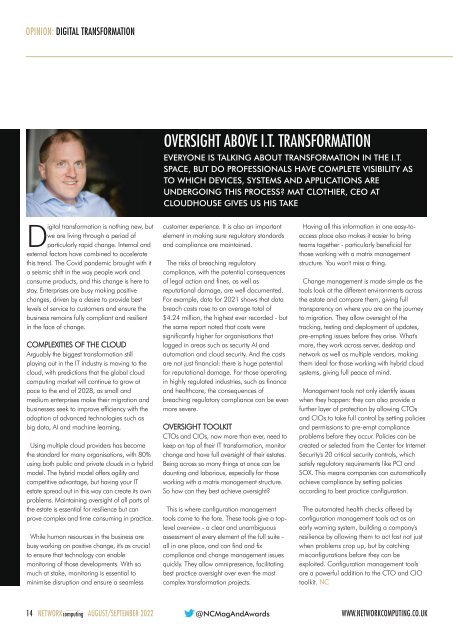NC Sep-Oct 2022
Create successful ePaper yourself
Turn your PDF publications into a flip-book with our unique Google optimized e-Paper software.
OPINION: DIGITAL TRANSFORMATION<br />
OVERSIGHT ABOVE I.T. TRANSFORMATION<br />
EVERYONE IS TALKING ABOUT TRANSFORMATION IN THE I.T.<br />
SPACE, BUT DO PROFESSIONALS HAVE COMPLETE VISIBILITY AS<br />
TO WHICH DEVICES, SYSTEMS AND APPLICATIONS ARE<br />
UNDERGOING THIS PROCESS? MAT CLOTHIER, CEO AT<br />
CLOUDHOUSE GIVES US HIS TAKE<br />
Digital transformation is nothing new, but<br />
we are living through a period of<br />
particularly rapid change. Internal and<br />
external factors have combined to accelerate<br />
this trend. The Covid pandemic brought with it<br />
a seismic shift in the way people work and<br />
consume products, and this change is here to<br />
stay. Enterprises are busy making positive<br />
changes, driven by a desire to provide best<br />
levels of service to customers and ensure the<br />
business remains fully compliant and resilient<br />
in the face of change.<br />
COMPLEXITIES OF THE CLOUD<br />
Arguably the biggest transformation still<br />
playing out in the IT industry is moving to the<br />
cloud, with predictions that the global cloud<br />
computing market will continue to grow at<br />
pace to the end of 2028, as small and<br />
medium enterprises make their migration and<br />
businesses seek to improve efficiency with the<br />
adoption of advanced technologies such as<br />
big data, AI and machine learning.<br />
Using multiple cloud providers has become<br />
the standard for many organisations, with 80%<br />
using both public and private clouds in a hybrid<br />
model. The hybrid model offers agility and<br />
competitive advantage, but having your IT<br />
estate spread out in this way can create its own<br />
problems. Maintaining oversight of all parts of<br />
the estate is essential for resilience but can<br />
prove complex and time consuming in practice.<br />
While human resources in the business are<br />
busy working on positive change, it's as crucial<br />
to ensure that technology can enable<br />
monitoring of those developments. With so<br />
much at stake, monitoring is essential to<br />
minimise disruption and ensure a seamless<br />
customer experience. It is also an important<br />
element in making sure regulatory standards<br />
and compliance are maintained.<br />
The risks of breaching regulatory<br />
compliance, with the potential consequences<br />
of legal action and fines, as well as<br />
reputational damage, are well documented.<br />
For example, data for 2021 shows that data<br />
breach costs rose to an average total of<br />
$4.24 million, the highest ever recorded - but<br />
the same report noted that costs were<br />
significantly higher for organisations that<br />
lagged in areas such as security AI and<br />
automation and cloud security. And the costs<br />
are not just financial: there is huge potential<br />
for reputational damage. For those operating<br />
in highly regulated industries, such as finance<br />
and healthcare, the consequences of<br />
breaching regulatory compliance can be even<br />
more severe.<br />
OVERSIGHT TOOLKIT<br />
CTOs and CIOs, now more than ever, need to<br />
keep on top of their IT transformation, monitor<br />
change and have full oversight of their estates.<br />
Being across so many things at once can be<br />
daunting and laborious, especially for those<br />
working with a matrix management structure.<br />
So how can they best achieve oversight?<br />
This is where configuration management<br />
tools come to the fore. These tools give a toplevel<br />
overview - a clear and unambiguous<br />
assessment of every element of the full suite -<br />
all in one place, and can find and fix<br />
compliance and change management issues<br />
quickly. They allow omnipresence, facilitating<br />
best practice oversight over even the most<br />
complex transformation projects.<br />
Having all this information in one easy-toaccess<br />
place also makes it easier to bring<br />
teams together - particularly beneficial for<br />
those working with a matrix management<br />
structure. You won't miss a thing.<br />
Change management is made simple as the<br />
tools look at the different environments across<br />
the estate and compare them, giving full<br />
transparency on where you are on the journey<br />
to migration. They allow oversight of the<br />
tracking, testing and deployment of updates,<br />
pre-empting issues before they arise. What's<br />
more, they work across server, desktop and<br />
network as well as multiple vendors, making<br />
them ideal for those working with hybrid cloud<br />
systems, giving full peace of mind.<br />
Management tools not only identify issues<br />
when they happen: they can also provide a<br />
further layer of protection by allowing CTOs<br />
and CIOs to take full control by setting policies<br />
and permissions to pre-empt compliance<br />
problems before they occur. Policies can be<br />
created or selected from the Center for Internet<br />
Security's 20 critical security controls, which<br />
satisfy regulatory requirements like PCI and<br />
SOX. This means companies can automatically<br />
achieve compliance by setting policies<br />
according to best practice configuration.<br />
The automated health checks offered by<br />
configuration management tools act as an<br />
early warning system, building a company's<br />
resilience by allowing them to act fast not just<br />
when problems crop up, but by catching<br />
misconfigurations before they can be<br />
exploited. Configuration management tools<br />
are a powerful addition to the CTO and CIO<br />
toolkit. <strong>NC</strong><br />
14 NETWORKcomputing AUGUST/SEPTEMBER <strong>2022</strong> @<strong>NC</strong>MagAndAwards<br />
WWW.NETWORKCOMPUTING.CO.UK

















